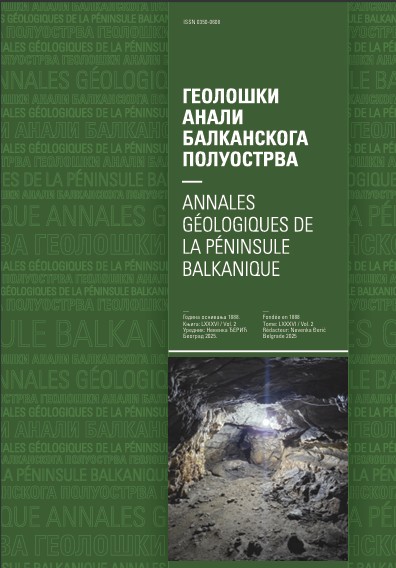Infrared spectra study of the Moslavačka Gora (Croatia) tourmalines O-H stretching region: inference of fluid involvement in the Late Cretaceous igneous evolution of a complex Adria – Europe convergence zone
Abstract
Infrared spectra (IR) in the O-H stretching region were recorded for natural tourmalines from the magmatic and magmatic-hydrothermal systems of Moslavačka Gora (Croatia). Samples of disseminated tourmaline (schorl) representing magmatic products were collected from leucogranite. Nodular tourmaline (intermediate members of the schorl-dravite series) from twomica granite represents a magmatic-hydrothermal mineral related to the final stage of granite crystallization. IR spectra of the typically disseminated tourmaline show four sharp O-H stretching bands: 3643, 3633, 3550, and 3484 cm-1, while typical nodular tourmaline shows spectra with asymmetric and relatively broad O-H stretching bands on 3635 and 3554 cm-1 with shoulders at the higher and lower wavenumber side. The broadening in the lower wavenumber region of nodular tourmaline compared to disseminated tourmaline indicates a higher water content in the nodular type. At the same time, the observed shifts between the corresponding bands can be explained by the shortening of the O-H1 and O-H3 distances, which can be attributed to different genetic and/or evolutionary processes. According to the models applicable to the Moslavačka Gora, disseminated tourmaline from the leucogranite can be considered a typical magmatic (pegmatitic) product and a standard accessory phase of the leucogranite. The origin of nodular tourmaline, which was the last mineral to crystallize in the evolved Late Cretaceous granitic system of Moslavačka Gora, is attributed to the interaction of a fluid phase from the residual granitic melt with the fluid originating from the wall-rock in the low-pressure crustal setting, which was accompanied by relatively rapid cooling. This interaction resulted in an increased dravite content of the nodular tourmaline and is reflected in the observed IR spectral features.
Copyright (c) 2023 Geološki anali Balkanskoga poluostrva

This work is licensed under a Creative Commons Attribution 4.0 International License.










